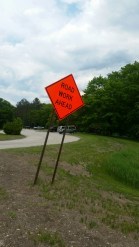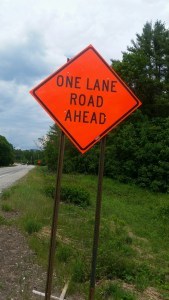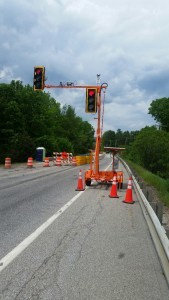Carrying the flag
Sometime during the last century when I was a child, nothing pleased my sister and me more than coming upon a road construction project while in the car with our parents.  When we saw the first cautionary sign, we hoped for one-lane traffic because it could mean we would carry the flag. That’s what it was called. If you were a single car or the last in a line, a worker would hand in a small flag that you carried to the other end of the construction and passed on to the worker there. He (and it was always he then) knew that traffic could go through in the single lane in the opposite direction, back to where you had come from. My sister and I had an unstated agreement to take turns carrying the flag. One construction project might be a part of a larger program that meant we had several opportunities in a single trip, or it might be that weeks or even months would go by before the opportunity came again. But we knew which of us would get to hold the flag and pass it to the worker at the other end. We just hoped to get lucky and be a single car or be the last in the line.
When we saw the first cautionary sign, we hoped for one-lane traffic because it could mean we would carry the flag. That’s what it was called. If you were a single car or the last in a line, a worker would hand in a small flag that you carried to the other end of the construction and passed on to the worker there. He (and it was always he then) knew that traffic could go through in the single lane in the opposite direction, back to where you had come from. My sister and I had an unstated agreement to take turns carrying the flag. One construction project might be a part of a larger program that meant we had several opportunities in a single trip, or it might be that weeks or even months would go by before the opportunity came again. But we knew which of us would get to hold the flag and pass it to the worker at the other end. We just hoped to get lucky and be a single car or be the last in the line.
I don’t know when the change came, but by the time we were driving our own car with our son aboard the practice had evolved and flaggers at each end of a construction project used radios to control the flow of one-way traffic. Since my wife had similar memories of carrying the flag as a child, we of course regaled our son with stories that he no doubt found quaint. The use of radios improved efficiency, but not having the chance to carry the flag made the experience less fun.
At some point in the not too distant past the practice changed again. Today we find that traffic flow in many construction projects is controlled by temporary stop lights: no workers at either end, just a timed light signaling the moment to drive through the one-way stretch. Someone has obviously decided this approach further increases efficiency—and obviously reduces costs by eliminating the presence of flaggers at both ends of a project. 
So why do I find myself yearning for the opportunity to carry a flag—or, more precisely, to have my granddaughter enjoy that experience while we’re transporting her? Nostalgia, of course. Who doesn’t want to re-live one’s youth? And allow a new generation to enjoy a pleasure one had in the far past?
But I also think about this in a larger context. The development from carrying the flag to dual flaggers to temporary stop lights reflects trends in the economy:
*the substitution of capital (in the form of those temporary stoplights that some firm rents to contractors) for labor
*the increasingly impersonal nature of transactions and communications
*more humane working conditions, which surely benefit the women and men who used to stand for long hours in winter’s cold and summer’s heat to direct the flow of traffic.
That’s a mixed bag of negative and positive developments, and there’s little I can do to slow down the negatives and speed up the positive. But when I come upon a construction project that requires one-way traffic, I’m not really thinking about economic trends. I’m still hoping—fantasizing, really—that my granddaughter might be handed a flag that she can proudly carry. And tell that story to her child or grandchild.
Lea Wait's Blog
- Lea Wait's profile
- 506 followers



